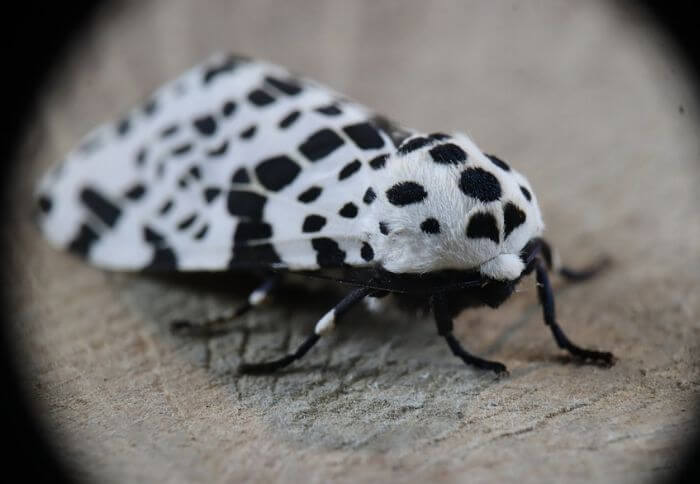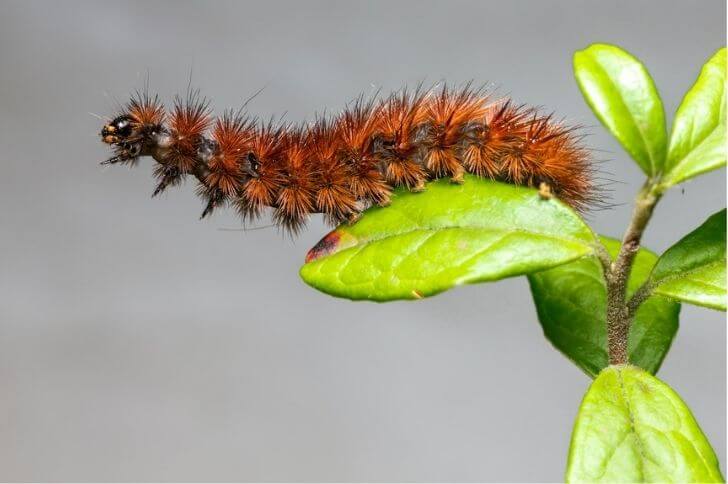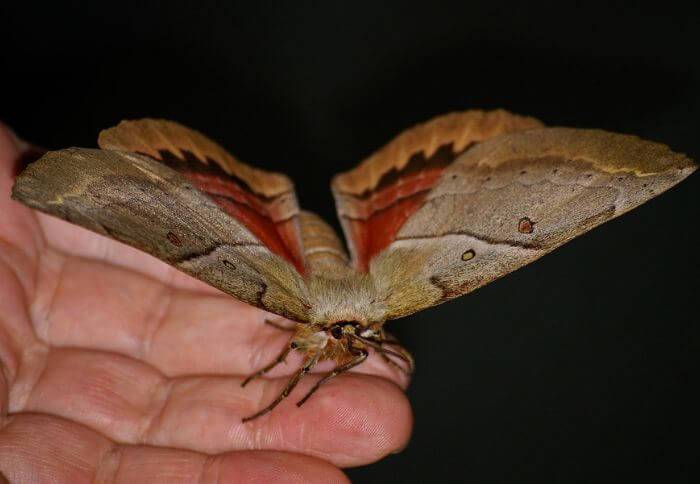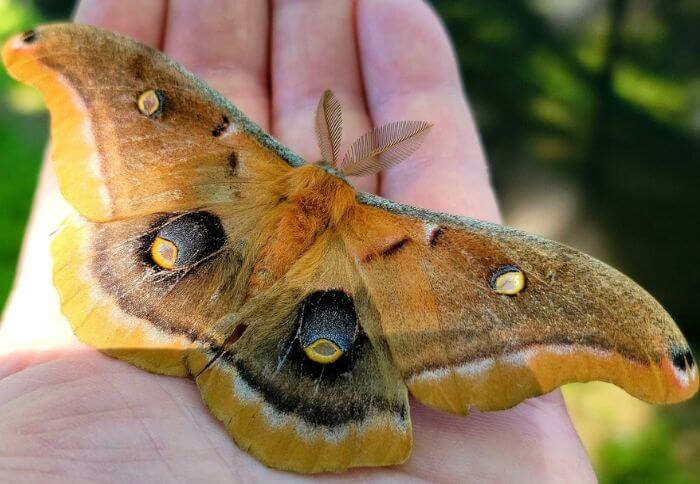7 Pink and Brown Moths (Images)
In a world filled with vibrant butterflies and striking birds, it’s easy to overlook the subtle beauty that lies within moths. But what if I told you that among this seemingly ordinary insect family exists an extraordinary array of pink and brown moths?
From delicately patterned wings that mimic blooming flowers to astonishing camouflage techniques perfected over generations, these elusive creatures hold secrets waiting to be unraveled. Embark on a journey with us as we explore the dazzling realm of pink and brown moths, where hidden wonders await at every turn.
Pink and Brown Moths
1. Elephant Hawk Moth

Beneath the twilight sky, a mysterious creature gracefully takes flight. The elephant hawk moth, with its beautiful blend of pink and brown hues, captivates both nature enthusiasts and casual observers alike. But there is more to this bewitching insect than meets the eye.
One of the most fascinating aspects of the elephant hawk moth is its impressive ability to mimic other creatures in order to protect itself from predators.
When disturbed or threatened, it extends its hindwings revealing striking eye markings resembling those of an owl. This ingenious adaptation can startle potential attackers or confuse them long enough for the moth to make a swift escape.
While many moths are nocturnal beings, the elephant hawk moth has still managed to carve out a niche as an active daytime pollinator.
It possesses an elongated proboscis that allows it to reach deep into tubular flowers like honeysuckles and foxgloves, where it feeds on nectar while simultaneously transferring pollen between plants.
In doing so, this remarkable creature plays a crucial role in ensuring the survival and reproduction of various plant species.
Intriguingly adaptable and undeniably stunning, the elephant hawk moth offers us a glimpse into the wonders of nature’s intricacies. Its unique coloration serves not only as an aesthetic spectacle but also as a weapon for self-preservation.
Next time you happen upon this enchanting creature flitting through your garden, take a moment to appreciate its resilience and importance in maintaining our delicate ecosystem.
2. Privet Hawk Moth (Sphinx ligustri)
One of the most stunning moths in the world, Sphinx ligustri, commonly known as the Privet Hawk Moth, is a true marvel of nature. With its vibrant pink and brown coloring, it is almost impossible to miss.
In flight, this moth resembles an elegant ballet dancer gracefully gliding through the air. Its delicate wings appear to be painted with exquisite patterns that showcase a perfect balance between boldness and subtlety.
But what truly sets Sphinx ligustri apart from other moths is its incredible size. With wingspans measuring up to 4 inches (10 cm) across, it is one of the largest species of hawkmoths on the planet.
This impressive size allows it to soar through the night with unmatched grace and agility. Whether you encounter it in your own backyard or while exploring a dense forest habitat, this majestic creature will undoubtedly leave you enchanted by its beauty and uniqueness.
Beyond its breathtaking appearance, Sphinx ligustri also plays a vital role in our ecosystem as a pollinator. Like their butterfly counterparts, these pink and brown moths have long tongues that allow them to sip nectar from flowers deep within their blooms.
As they transfer pollen from one plant to another during their feeding sessions, they inadvertently contribute to plant reproduction and genetic diversity.
The exceptional combination of striking aesthetics and ecological importance make Sphinx ligustri a true treasure worth celebrating.
3. White-lined Sphinx
The white-lined sphinx, scientifically known as Hyles lineata, is a mesmerizing moth that boasts an intricate combination of pink and brown hues. What sets this species apart is its ability to hover in mid-air like a hummingbird while feeding on nectar from various flowers.
Its long proboscis allows it to probe deep into the corolla of blossoms, drawing out rich nutrients not easily accessible to other insects. This unique behavior has earned the white-lined sphinx the nickname hummingbird moth.
One fascinating aspect of these moths is their reproductive strategy. Females typically deposit their eggs on plants that will serve as food for their caterpillars once they hatch.
Interestingly, they display a peculiar sense of selectivity when choosing host plants, often preferring ones that are poisonous or toxic to other organisms.
It is believed that this preference serves as protection against potential predators, allowing the developing caterpillars to consume toxic compounds without harm.
Also read: Learn about types of white moths
4. Vine Hawk Moth
The vine hawk-moth, an enchanting member of the Sphingidae family, is a captivating creature that commands attention with its vibrant colors and impressive size.
With wingspans reaching up to four inches, these moths are truly a sight to behold. They are primarily found in the tropical regions of Africa and Asia, where they can be seen gracefully fluttering among lush vegetation.
One intriguing aspect of the vine hawk-moth is its unique coloration. While most moths tend to blend into their surroundings with muted tones and patterns for disguise, this moth boldly displays shades of pink and brown on its wings.
This color combination not only acts as a visual delight but also serves as an important form of communication for mating rituals. The vibrant pink acts as an attraction signal for potential mates while the earthy brown provides excellent camouflage when resting on tree bark or foliage.
Interestingly, the vine hawk-moth possesses exceptional flight capabilities. Its broad and powerful wings enable it to hover effortlessly in mid-air while collecting nectar from flowers with its long proboscis.
These agile fliers have evolved specialized wing muscles that allow them to fly quickly and skillfully through dense forests in search of sustenance or suitable nesting sites. As twilight descends upon the land, the moth’s natural instincts guide it towards night-blooming plants where it can continue to thrive under the moonlit skies.
5. Small Emperor Moth (Saturnia pavonia)
The Saturnia pavonia, commonly known as the small emperor moth, is an extraordinary example of nature’s artistry. The vibrant pink and brown wings of this striking creature create a captivating display against a backdrop of lush green foliage.
But there is more to this moth than its beauty; it also possesses remarkable survival techniques that make it a truly fascinating species.
One intriguing detail about the Emperor moth is its ability to detect pheromones released by potential mates from remarkable distances, sometimes up to 7 kilometers away.
This exceptional olfactory sense allows the males to search for females even in vast landscapes. Once they find each other, an enchanting courtship dance ensues, with the male fluttering his wings and releasing pheromones of his own to signal his intentions.
Another interesting aspect of these pink and brown moths is their resilience during harsh environmental conditions. This pink and brown moth has evolved a unique strategy called diapause, where it can remain dormant for extended periods when faced with adverse weather or scarcity of resources.
By pausing its development during unfavorable seasons, this extraordinary moth can conserve energy and wait patiently for more favorable conditions before emerging from its cocoon.
6. Pink-spotted Hawkmoth (Agrius cingulata)
Agrius cingulata, commonly known as the Pink-spotted Hawkmoth, is a breathtaking creature that perfectly exemplifies the beauty of nature. With its vibrant pink and brown hues and intricate wing patterns, this moth is a true marvel to behold.
But it’s not just its appearance that makes Agrius cingulata fascinating; it also possesses some remarkable features and behaviors.
One interesting aspect of the Pink-spotted Hawkmoth is its ability to hover in mid-air while feeding on nectar from flowers.
This behavior is achieved through rapid wing movements which allow the moth to maintain a stable position, much like a hummingbird. By hovering in this way, Agrius cingulata can access nectar from deep within the flower petals, making it an efficient pollinator for various plant species.
Another intriguing feature of this brown and pink moth is its long proboscis – a slender tube-like structure used for feeding purposes. The proboscis allows Agrius cingulata to probe into flowers to extract sweet nectar as well as reach fruits or tree sap high above ground level.
This remarkable adaptation enables the Pink-spotted Hawkmoth to access food sources that are otherwise inaccessible to many other insects, giving it an advantage for survival in certain environments.
Also read: Brown and yellow moths
7. Pink Underwing Moth (Phyllodes imperialis)

source: bensamuel86
Phyllodes imperialis, also known as the Pink underwing moth, is a unique and captivating species that never fails to draw attention.
What sets this moth apart from others is its breathtaking coloration and intricate patterns that grace its wings. The delicate blend of soft pink hues with rich brown tones creates a visual spectacle that captures the imagination.
But there’s more to the pink underwing moth than just its vibrant appearance. This elusive creature has adapted remarkable survival tactics in response to its environment.
For instance, it has developed an ability to camouflage itself effectively against tree bark due to the intricate patterns on its wings, making it virtually invisible when resting during daylight hours.
Furthermore, despite being grouped under moths, Phyllodes imperialis exhibits behavior more commonly associated with butterflies.
They have been observed actively feeding on flower nectar, a habit rarely seen in moths. This intriguing aspect of their behavior adds another layer of fascination to these already mesmerizing creatures.
8. Atlas Moth (Attacus atlas)
The Attacus atlas, colloquially called the Atlas moth, is not only one of the largest moths in the world but is also an exquisite sight to behold. With its magnificent wingspan of up to 9.4 inches and intricate patterns ranging from shades of pink to golden-brown hues, it has captivated nature enthusiasts and scientists alike.
What makes this moth even more fascinating is its vibrant pink coloration, which stands out amidst a sea of earthy tones commonly seen in other moth species.
Although the pink coloration may initially seem like a flamboyant fashion statement designed to catch attention, it serves a crucial purpose for survival. Surprisingly, this striking hue acts as camouflage against predators in their natural habitat.
The pinkish hue actually resembles dried leaves or flowers that blend seamlessly with their surroundings when they rest on tree trunks or branches during daylight hours. By blending in so effortlessly, these stealthy creatures can avoid detection by predators and increase their chances of survival.
In addition to its stunning appearance and unique survival adaptation, the Attacus atlas also has a short lifespan compared to other moth species.
While most moths live for several weeks or even months, these majestic insects only have an average lifespan of about one week once they emerge from their cocoons as fully formed adults. This brief moment further adds to the mystique surrounding these pink and brown beauties.
source:
Passionate animal photographer with an unwavering love for capturing the essence and beauty of our furry friends.
With over five years of experience in the field, I have developed a unique ability to connect with animals on a deeper level, allowing me to create stunning and captivating images that truly reflect their personality.
Let’s collaborate to capture unforgettable moments that celebrate the unique bond between humans and animals!





